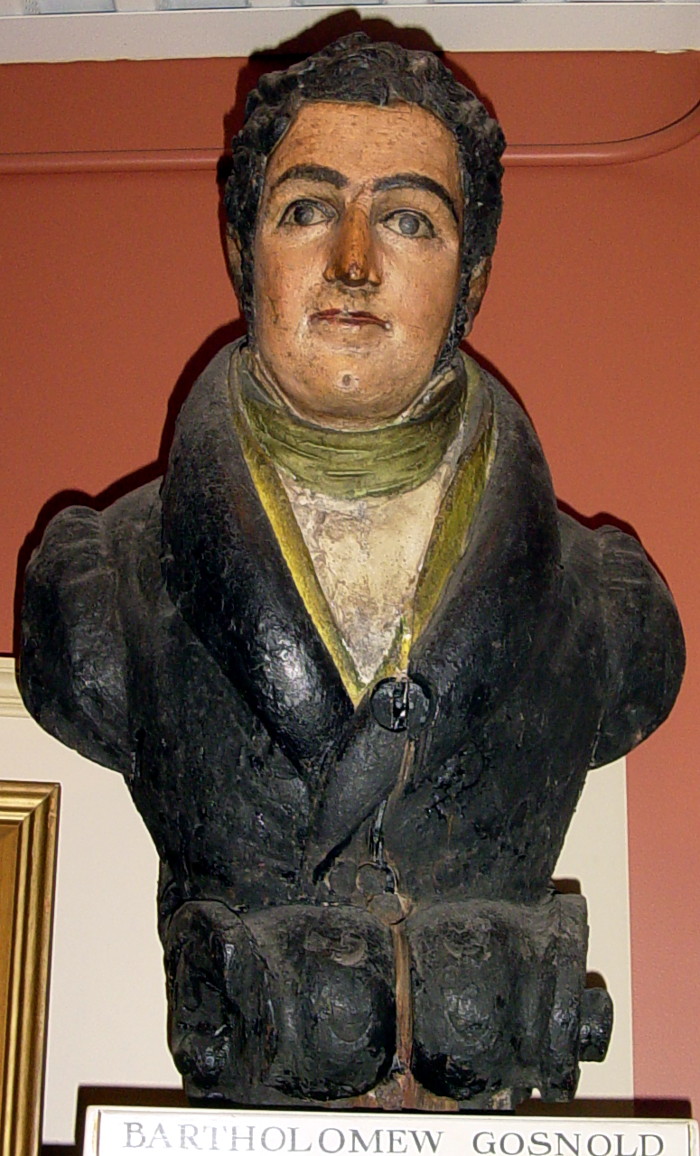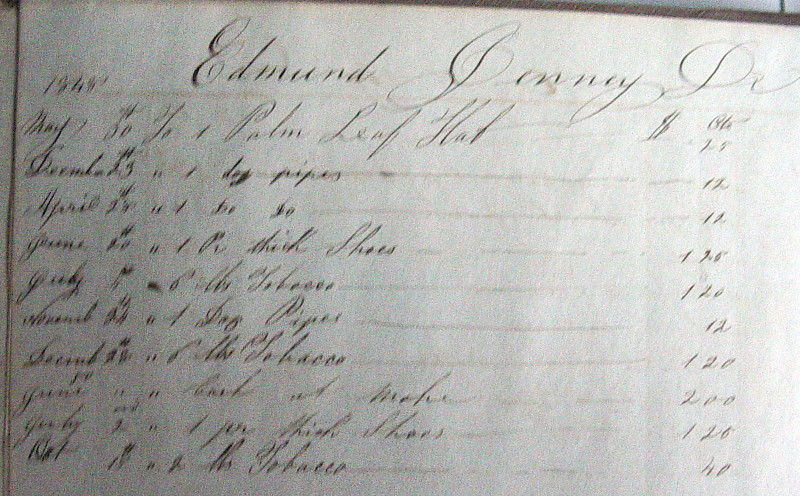A Whaling Account Ledger
Barbara and Sandy Moss
At a local antique show recently, we found, in the dusty clutter of a box of
stuff, a “journal,” with entries dated from as early as 1847. It had listings
of yards of cotton cloth, with prices attached. It seemed interesting, a
bargain was struck, and it came home with us.
When we looked over the journal after dinner, and it was apparent that this
wasn’t a normal commercial ledger or day book, but was an account book from a
sailing ship, and included the charges made to crewmen for their purchases from
the ship’s “slop chest,” as well as an accounting of the Master’s expenses and
bartering experiences while resupplying the ship during the voyage. The dates
of the transactions began in 1847, and ended in 1851. Further reading unearthed
the repetitive phrase, “Bark Gosnold.”
A search through Starbuck's "History of the American Whale Fishery" found
no bark of that name sailing in 1847. But Barbara, sharp at these things,
suggested that the spelling was not, “Bark Gosnold”, but “Bart. Gosnold,” and
this could be, “Bartholomew Gosnold”. And sure enough, there, in
Starbuck is the notation that the ship “Barthomew Gosnold” (356 tons)
sailed from New Bedford on June 28, 1847 on a voyage to the Indian Ocean,
returning on April 9, 1851, with 1,796 bbls of Sperm oil, 435 bbls whale oil,
and had sent home an additional 75 bbls of Sperm. Also noted was that the Third
Mate, John M. Austin died at sea in July, 1850. The Master was listed as, “____
Taber,” and the owner as I. Howland, Jr. & Co.
 Barbara
quickly downloaded the crew list for this voyage from the New Bedford Public
Library website, and it coincided closely with the crewmen’s names written in
the account book, even to the auction held on Aug 3, 1850 for the property of
John M. Austin, the deceased Mate noted in Starbuck. There can be no doubt that
this is the Master’s account book for that voyage of the Bartholomew Gosnold,
the figurehead of which adorns our “Portrait of a Port” display in the New
Bedford Whaling Museum! The Master was Reuben Taber, whose signature appears in
the ledger.
Barbara
quickly downloaded the crew list for this voyage from the New Bedford Public
Library website, and it coincided closely with the crewmen’s names written in
the account book, even to the auction held on Aug 3, 1850 for the property of
John M. Austin, the deceased Mate noted in Starbuck. There can be no doubt that
this is the Master’s account book for that voyage of the Bartholomew Gosnold,
the figurehead of which adorns our “Portrait of a Port” display in the New
Bedford Whaling Museum! The Master was Reuben Taber, whose signature appears in
the ledger.
And what interesting reading this is! We often talk to our Museum’s
visitors about the “Slop Chest”, but much of our information is anecdotal. The
"slop chest" was essentially the ship's store, opened periodically by the
Captain, and purchases drawn from it were charged to each crewman's account,
which was to be paid by the crewman at the time of settlement upon the
conclusion of the voyage. It is said that the Captain profited from the
sales from the slop chest, but this is not completely clear.
This account includes some real information about this subject. The main
categories of purchases on the Bart. Gosnold were for articles of
clothing, tobacco, cotton cloth, eating utensils, and jack knives (51 of which
were sold to the crew), as well as cash advances for shore leave at Mahe in the
Seychelles, and St. Helena (the ship also visited ports in Ceylon and the Comoro
Islands, but did not give shore leave to the crew). There were also charges
for “poliece” activity after shore leaves, unspecified charges paid to the
Captain of another ship, and one instance of the payment of a “Government Bond”
on behalf of a crewman for the hefty sum of $14.50.
The readable accounting (a couple of records are masked by later pasted-on
items, and some are partially missing) shows a total sale of items (plus cash
and other credits) of $1224.07 for the voyage. This was comprised of sales to
30 crewmen. The original crew list contains 30 names (plus Captain Taber), but
several on the original list are not mentioned in the account, and there are
additional names in the account. Clearly some crewman aborted their
responsibilities before sailing, and substitutes were found at the time of
sailing, or in the first ports visited in the Windward Islands. Of
the thirty account records (29 of which are readable), the average charge to the
slop chest is about 42 dollars. This works out to being only a little more than
$10 per year, per crewman, over the lifetime of the voyage. The most penurious
members were the cooper, Edmund Jenney ($7.92); seaman, Edward P. Smith
($11.77); greenhands, Frederick Lambert ($12.41) and Samuel Lewis ($12.71); John
Cruis ($14.01); and the cabin boy, William F. Blossom ($15.21). Blossom did not
receive a ‘lay’, but had signed on for a flat $50.00 for the voyage. He, at
least, appears to come out ahead.

The complete record for Edmund Jenney, Cooper

Partial record for William P. Flowers, crewman
At the other end of the scale, the big spenders were seamen, William Rogers
($98.03); Francewar Roselor ($72.10); and James Wentworth ($70.59). Two crewmen
who died during the voyage (greenhand, George Coggeshall, and 3rd
mate, John Austin) ended with net credits derived from the auctions of their
belongings—worth $10.85 and $51.00 respectively.
A list of the types of clothing (and bedding) sold from the slop chest is
fairly diverse. It includes:
Bound
Jacket 4.25
Cotton
Handkerchiefs .20
Cotton
Sheet 1.00
Cotton
Shirt 1.00
Drawers 1.25
Duck
Frock 1.25
Duck
Pants 1.25
Fancy
Shirt 1.00
Flannel Shirt 2.00
Flannel Under Shirts 1.25
Gurnsey Frock 1.25
Monkey
Jacket 6.75
Morocco Pumps 1.25
“Old”
Pillow & Bed 1.00
Palm
leaf hats 0.25
Reefing Jacket
4.25
Scotch
Cap 0.40
Striped Cotton Shirt 1.00
Tar
Hat .60
Thick
Pants 2.75
Thick
Pumps 1.25
Thick
Shirt 2.00
Thick
Shoes 1.25
Under
Shirt 1.25
Whiting Blanket 1.25
Wool
Hat 1.00
Tobacco sold for .20 per pound (less for “old” tobacco), cigars for $1.00
for 300, and pipes for 0.12 per dozen.
Jack knives cost 0.30 each. And a set of tin pot, pan, and spoon cost. 0.50.
It is clear from the accounting, that while some crewmen purchased cotton
cloth and thread (1/4 pound for $0.40) for their own sewing, others bought
relatively large amounts of fancy printed cotton (say, 50 yards), with the
apparent intent of using it for barter when ashore or, during gams. Captain
Taber includes a careful accounting of the cloth inventory carried on the ship
(“Fancy Cotton” – 690 ¼ yds; “Blue Drills’ – 632 yds; “Blue Cotton” –1704 yds;
“Brown Cotton” –720 yds; “Fancy Prints”—1457 ¼ yds ). And, above what was
charged off to the crew (around 25% of the total inventory), this was a
principal resource in bartering for food, or selling for cash during the
voyage. Other bartering items included tobacco, muskets, kegs of powder, empty
casks ($1 per cask), and “narrow” axes.
The accounts include a page of “Bounty” that appears to represent
withdrawals from the slop chest for the personal use of Captain Taber. There
are no cash charges listed, but the items include a reefing jacket, 4 pairs of
thick pants, two shirts (one calico), 4 pairs of drawers (as many as bought by
the entire crew), and 1100 cigars. We surmise that Captain Taber was a
fastidious cigar smoker!
It is often said that the captains of whaling ships charged exorbitant
prices for goods in the slop chest. Captain Taber charged his crew about $0.15
per yard for the cloth. When bartering ashore he set the cash value of the
cloth at $5 per “piece” of cotton. A “piece” was about 33 yards of material.
At $0.15 per yard, a “piece” would sell to the crew for $4.95; or about the same
as the trade value. Also, Captain Taber routinely bartered both old and new
tobacco for food stuffs at various ports, where his valuation of the tobacco was
$0.25 a pound But, he charged the crew $0.20 for new, and much less for “old”
tobacco. It seems like the crew was getting a fairly good deal.
We’ve not done a comparison of the prices for clothing compared to
contemporary prices ashore, But Laura Perreira, in theWhaling Museum Research
Library, uncovered an account book from the ship Morea that sailed from New
Bedford in 1853 (6 years later than did the Bartholomew Gosnold). This
book includes the costs of items in the slop chest, as well as the recommended
prices of them to the crew. So, we find that the ship agent paid between $0.10
and $0.16 for tobacco, which was sold to the crew and traded for $0.40 per
pound. Various grades of cloth cost between $0.07 ½ and $0.9 ¼ per yard, and
were sold or traded at more than double the cost. The markup on clothing sold
from the slop chest was about double. So, it would appear that the crew of the
Bartholomew Gosnold was paying double the wholesale cost for their purchases
from the slop chest. Still, we don’t know what the same items would have cost
retail ashore, but it doesn’t appear that the crew was being “gouged”
outrageously.
Yet another account book from the bark Morning Light that sailed in
1856 lends more light to the issue of the slop chest. This accounting makes
clear that cash loans (both advances before the voyage, and loans from the
Master for shore leaves) were charged a flat 25% interest for the duration of
the voyage. Thus, a $4 loan was considered as a $5 charge at the time of
settlement. The cash advances to the crew of this voyage were much higher than
on the Bartholomew Gosnold. Coincidentally, the desertion rate was very
high on this voyage, with a number of discharges occurring as well. The
Barthomew Gosnold voyage apparently had no desertions from the crew. When a
crew member on the Morning Light was discharged, a settlement occurred that
resulted in a waiving of the slop chest purchases and cash advances, with the
addition (in some cases) of additional items from the slop chest—especially
yards of cloth—and a small amount of cash. The slop chest contributions, of
course, cost the owner’s only half of the cash equivalent.
The Bartholomew Gosnold journal concludes with a detailed section of
“Disbursements and Port Charges” that is enlightening for its details of
bartering for supplies, as well as for payments made to a number of other
Captains, Port Authorities, Consulates, Doctors, Police, etc. It opens a new
door to us on the business of whaling. In many ways these account books are
more informative (but apparently less commonly found) than the log books!
RETURN